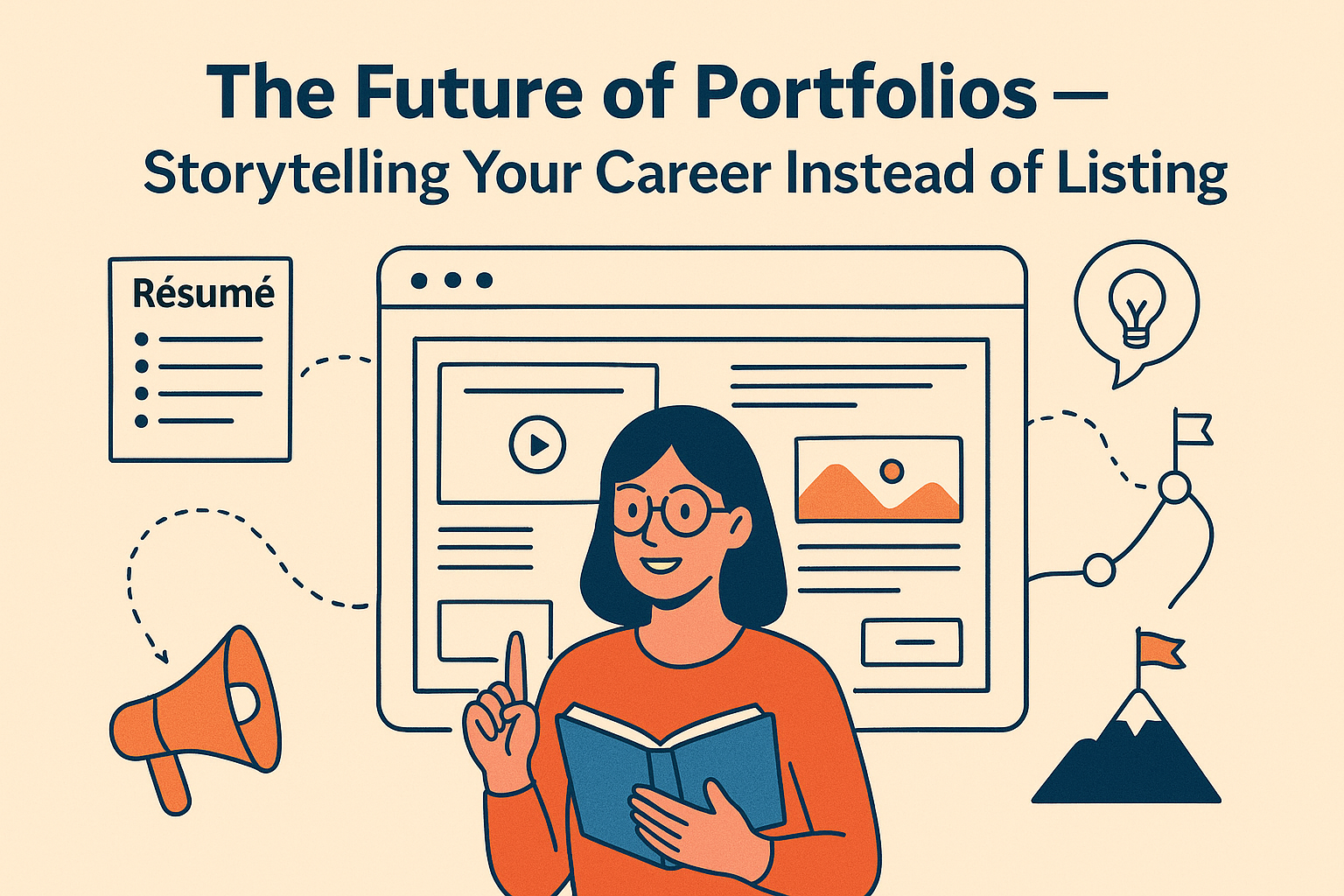The Future of Portfolios — Storytelling Your Career Instead of Listing It
Introduction
The era is over when a portfolio was merely a compilation of work samples with a few bullet points. The audience expects to experience your journey, not just read about it. The contemporary portfolio has been transformed into an experience in storytelling-communicating the ideas, challenges, and evolution that support your work. It is less about laundry-list accomplishments and more about unveiling the human beyond the skills. The times have changed; how you tell the story can be just as important as the story itself.

Moving Beyond Résumés to Narratives — The Evolution of Our Work Storytelling
For a long time, résumés were the quintessential way to demonstrate our workplace value, with pointed bullets, job titles, and timelines arranged in neat rows. Alas, we have outgrown that approach based on our modern world. Today, people care less about what you did and care more about why you did it. A narrative style of telling our career story puts life back into our careers and professional lives by describing with clarity and purpose our passion and milestones as well as the journey of how we learned along the way. Rather than a flat list of experiences, a narrative style recounts each journey for each milestone — and west of all, creates some authenticity towards how it is memorialized. Instead of saying, “I led a team,” it could instead imply overcoming uncertainty, inspiring collaboration, or learning through failure or success.
This shift is not purely to inform — but to connect. It makes “your work” more of a human experience. Whether you are a designer, marketer, or developer, your story, rather than a résumé, is what gives your portfolio its heartbeat, paces its narrative, and makes it far more engaging than a traditional résumé could ever offer.
The Benefit of Context — Change Projects into Journeys
A project without context is just work. Share what inspired the project, what challenges you encountered, and what you learned, and suddenly that project has a different meaning. Context can turn projects into journeys that reflect your creative process, decisions, growth mindset, etc. It gives others insight into how you were thinking, not just what you produced. For example, instead of showing a brand logo you designed, you would explain the challenge the brand had, what you brainstormed, and what the last “aha!” moment was. You’re inviting the viewer into your process and making your work more relatable and impactful. Sharing context builds trust — people feel they “know” the person behind the project. Whether you work as an independent or are a corporate employee, adding context is a way to turn your portfolio from a static display of what you did, into a living, breathing narrative of who you are and how you’ve grown.

Digital Portfolios as Personal Brands
Your digital portfolio is much more than a bin of your work – it is the home of your personal brand. Each color, font, and sentence contributes to your narrative. The design of the portfolio reveals your aesthetic, the tone conveys your personality, and the layout embodies your clarity of thought. Professionals are using tools like Notion, Webflow, and Squarespace to create portfolios that feel alive, growing as their careers evolve. The portfolio is no longer “finished;” it is a living embodiment of your values and growth instead. Employers and clients look for more than skills; they are looking for the relatable – a different story that aligns with their mission. By curating your digital space, you are exhibiting not only what you do, but who you are and how it matters. Your portfolio is no longer proof of work, but who you are, and why that is important to you in a digital-first world.
AI and the Future of Career Storytelling
AI is reshaping how we create, define, and articulate our professional accounts of ourselves, often without people recognizing it. Tools that harness AI, like ChatGPT, Notion AI, and story generators, can help people re-write their raw career information into engaging stories, summaries of themselves, or even visuals. Imagine uploading your résumé and AI generates a beautifully articulated story of your career — your history, values, skills, and accomplishments— in a uniquely authentic voice. AI can help with articulating tone of voice, help customize visuals, and suggest ways of sharing your story with greater emotional impact. We are not simply refashioning text, but AI-enabled tools now allow for dynamic portfolios — in the form of auto-generated timelines, for video explainers with an avatar. But the main takeaway – AI does not replace you, but makes your life easier. The true magic occurs when technology allows you a chance to materially express your journey with greater confidence, while you devote yourself completely to greater meaning. The future of portfolios is a collaboration between human authenticity, and the creative capacity that comes from AI – in which data into story, and story leads to connection.
Conclusion
Portfolios of the future focus on connection over collection. By sharing your authentic, deep, and honest career story, you let a stranger see you — the person behind the projects. It’s not just a credentials list anymore. It’s about sharing the experiences that have shaped who you are today. In a world filled with data and automation, storytelling keeps your career human, memorable, and truly your own.
